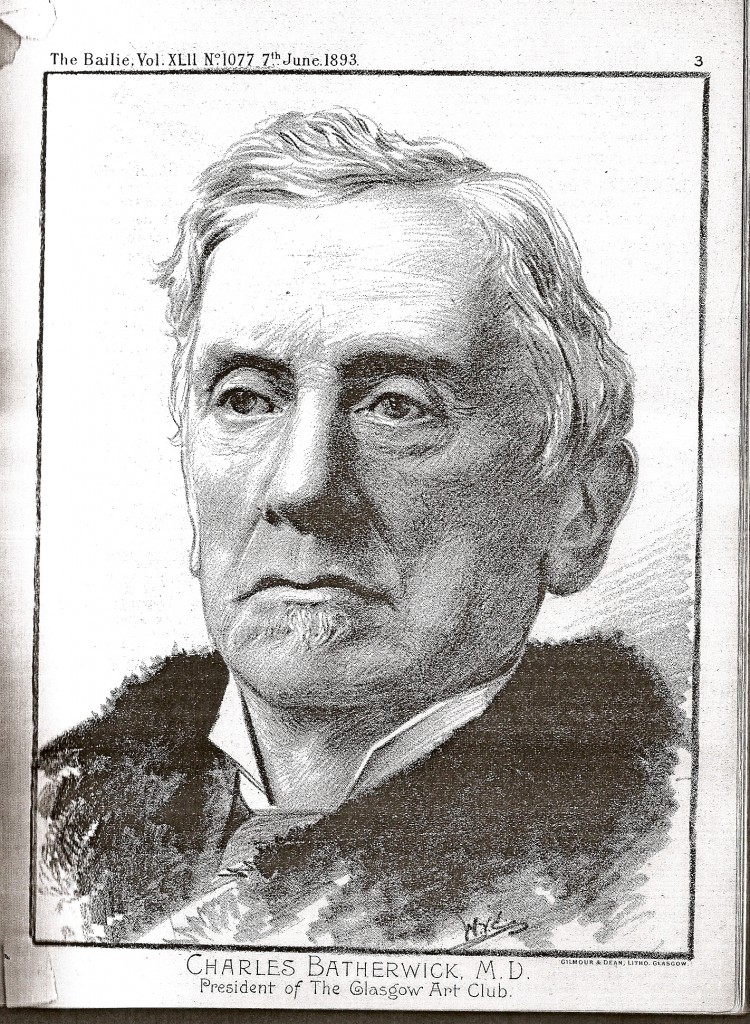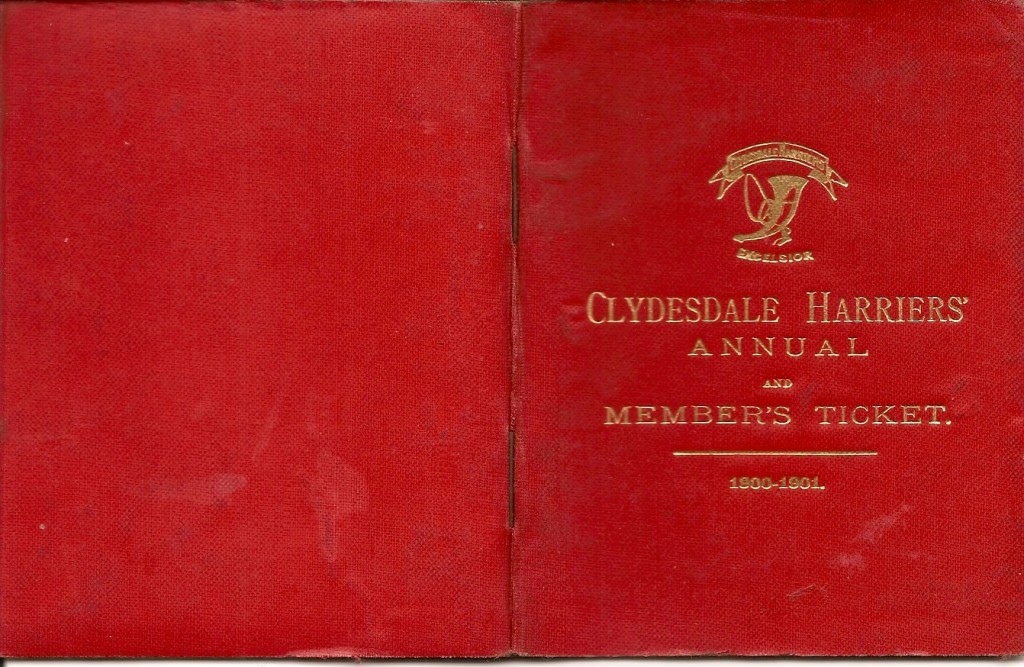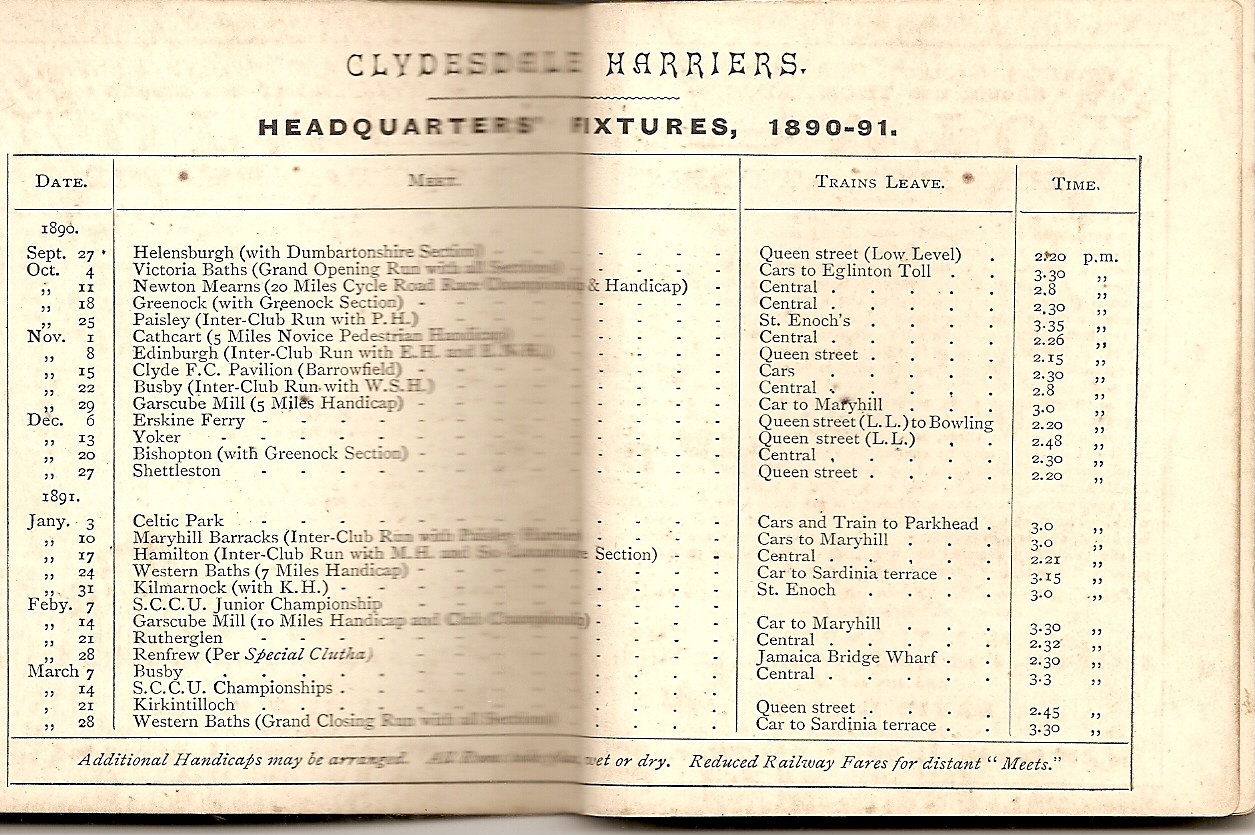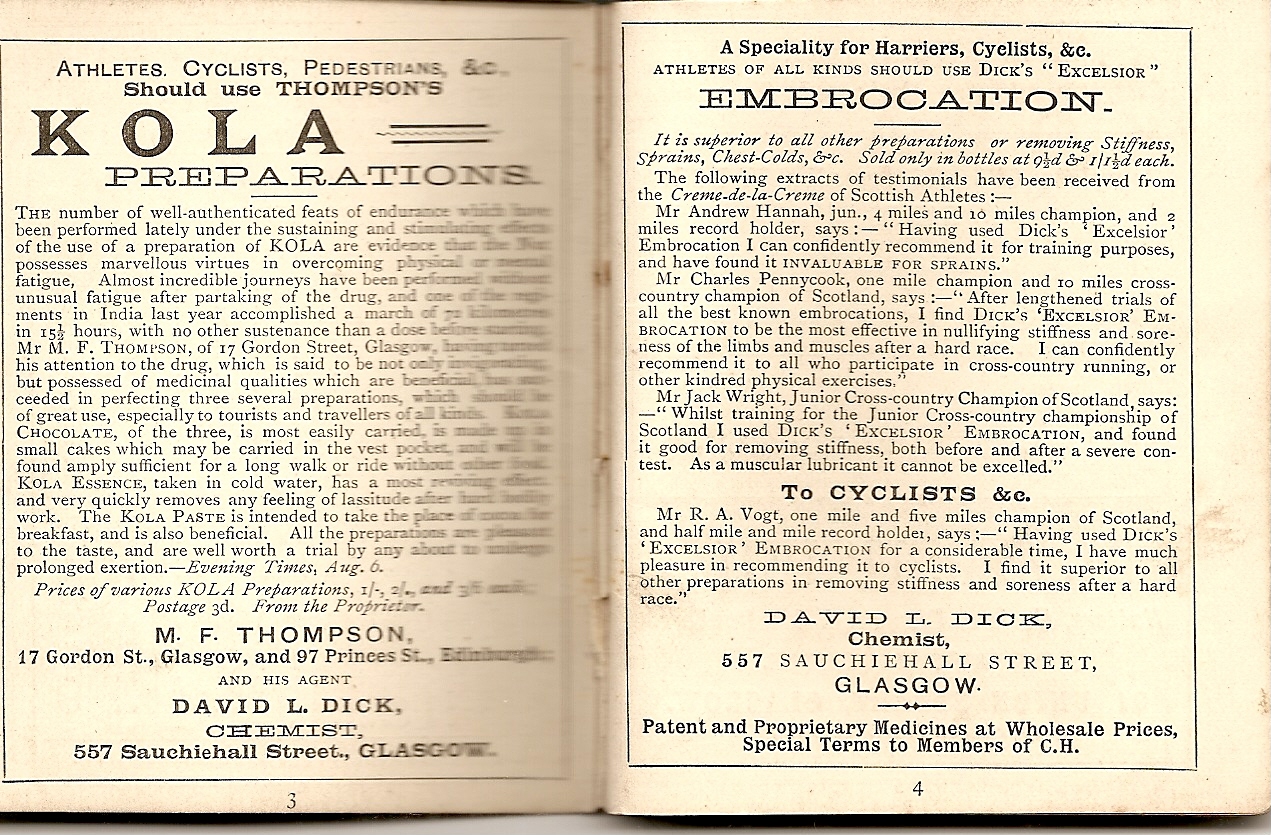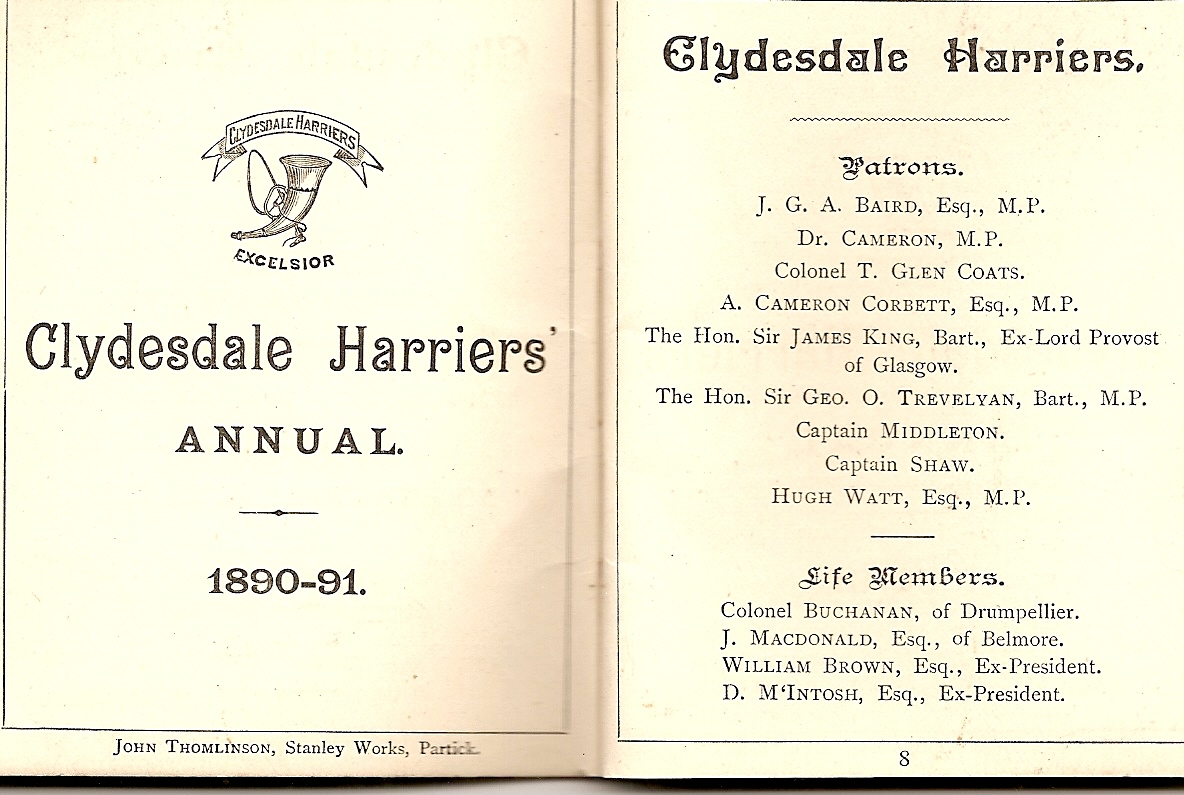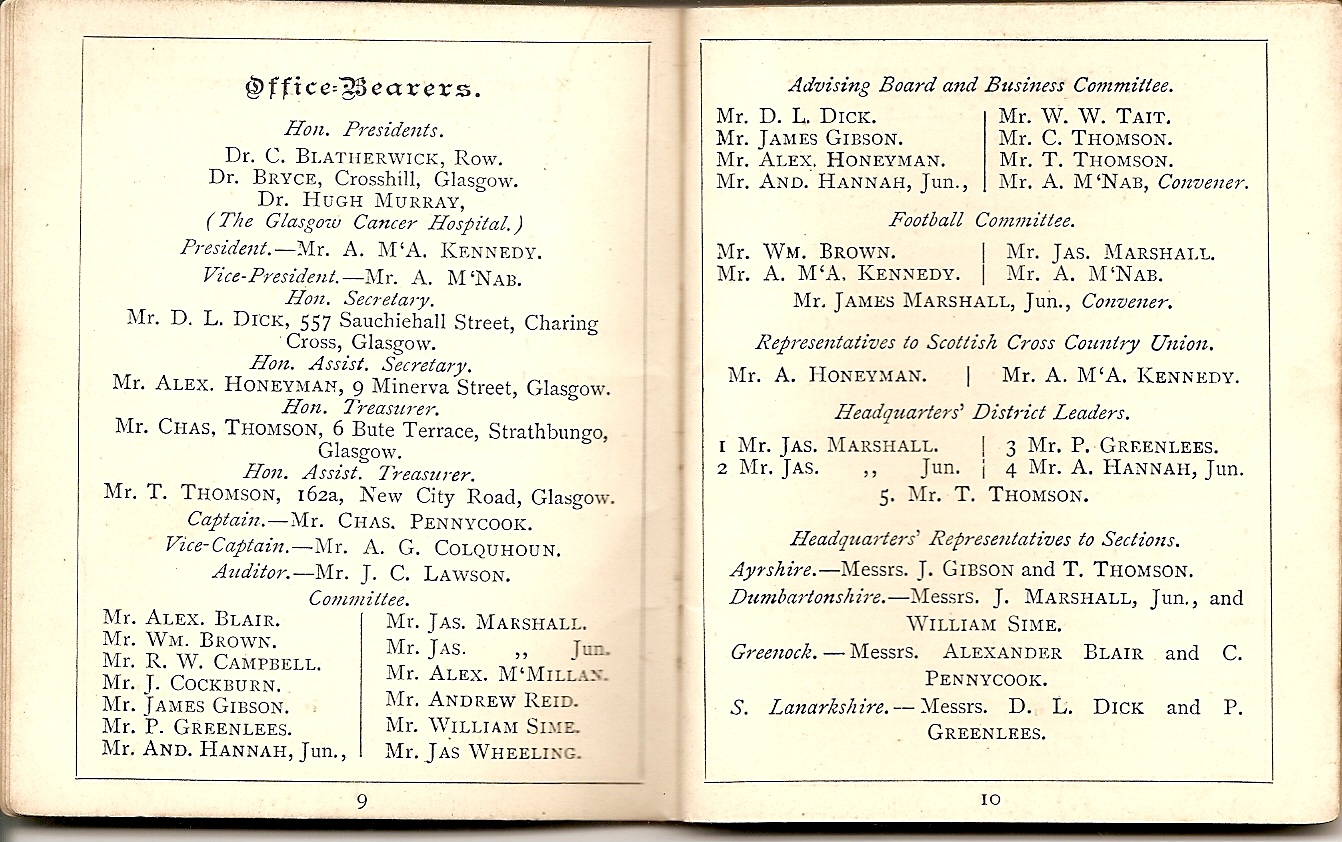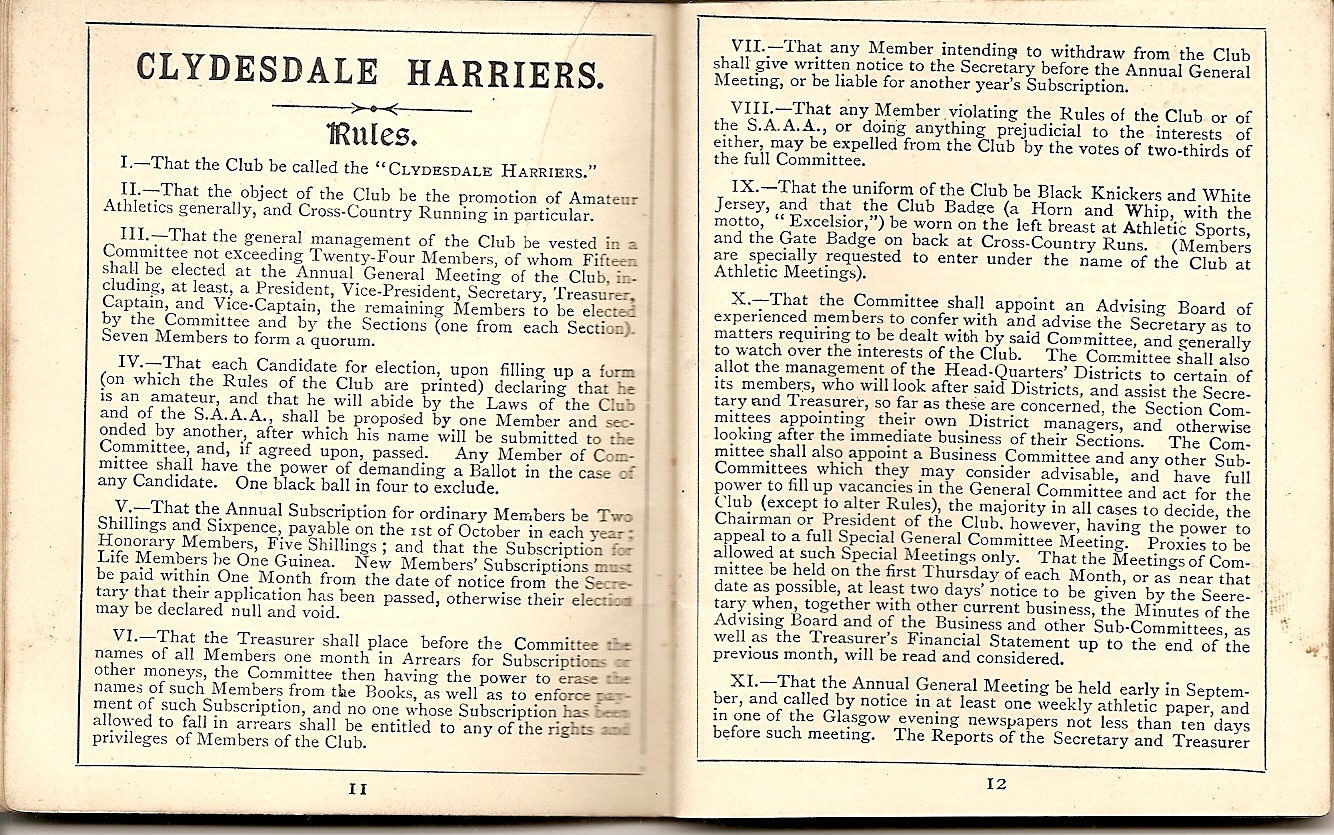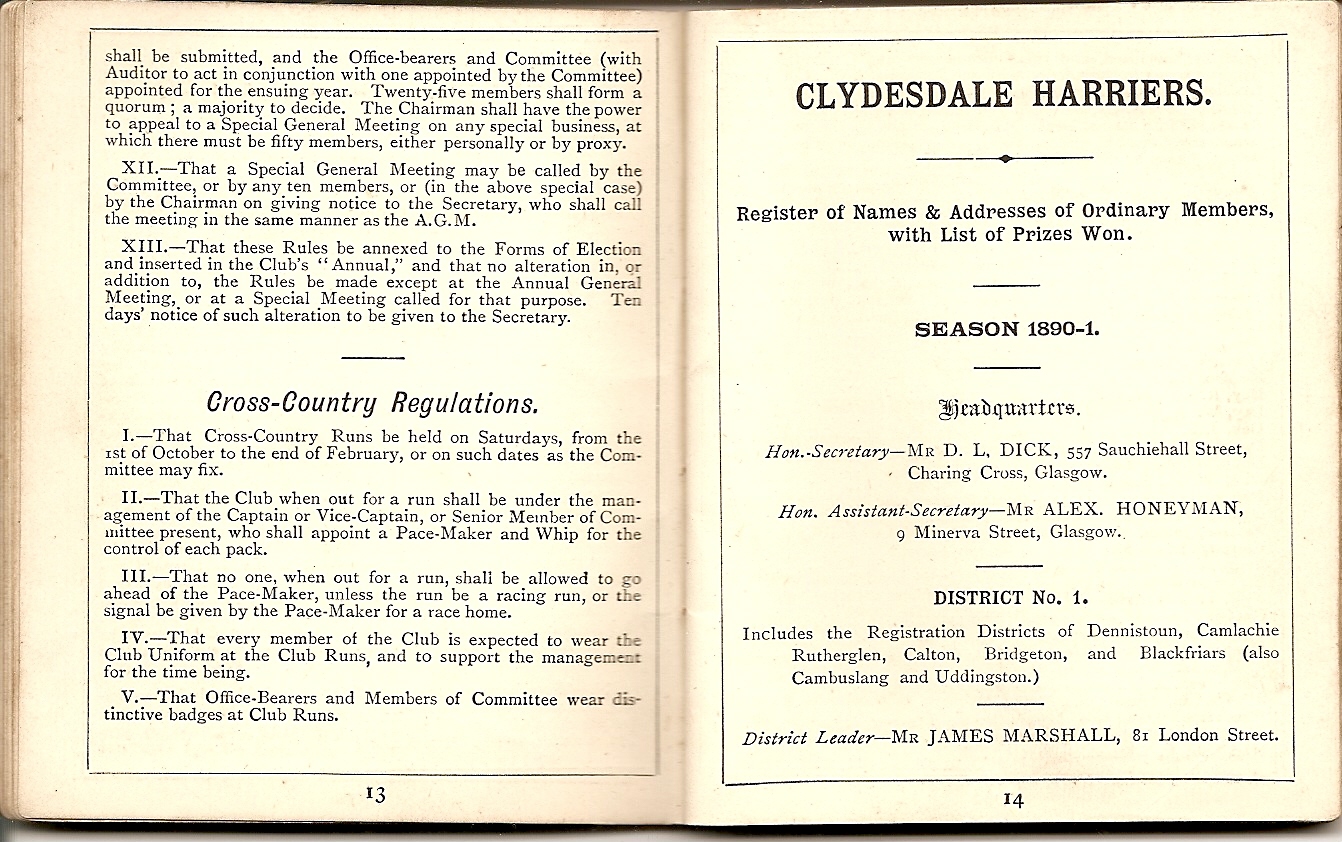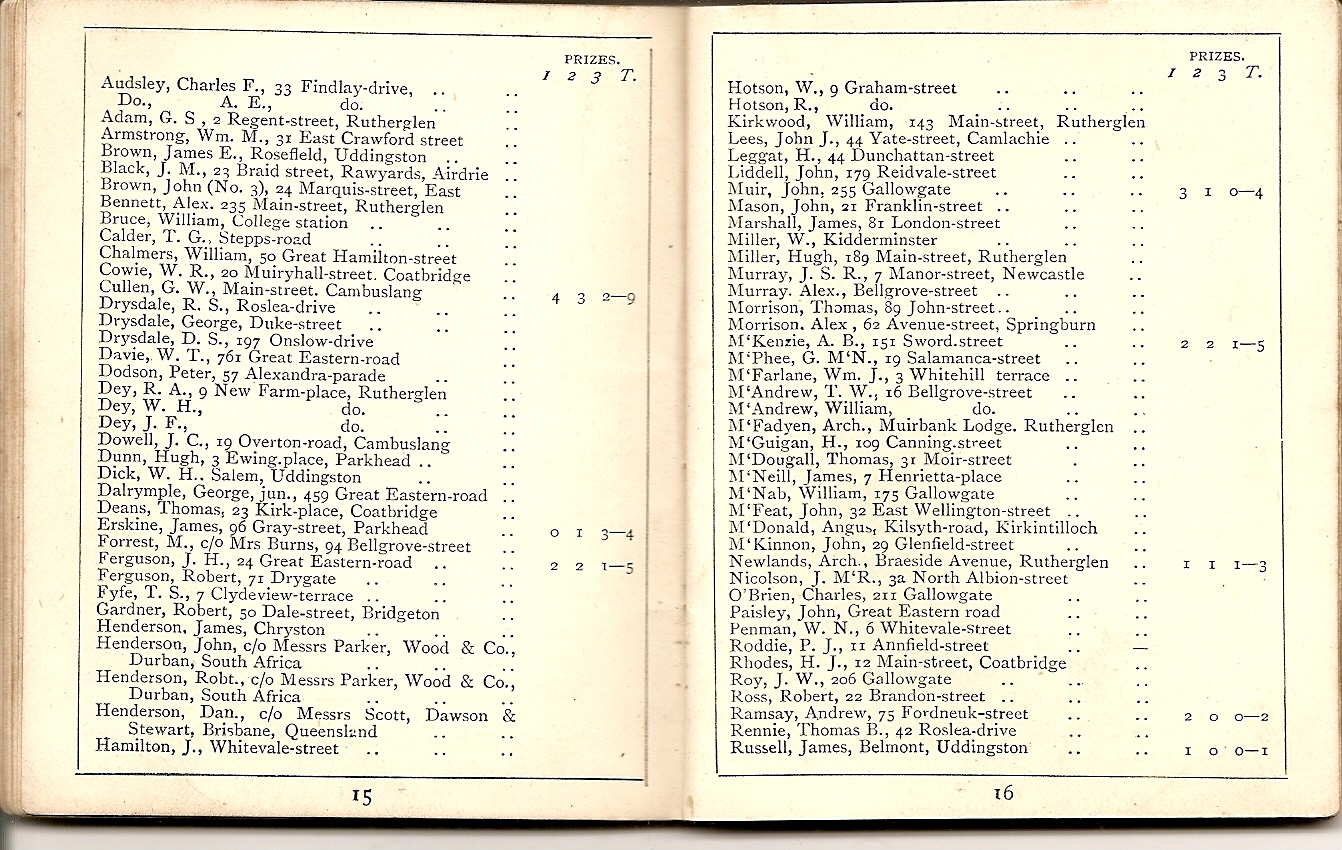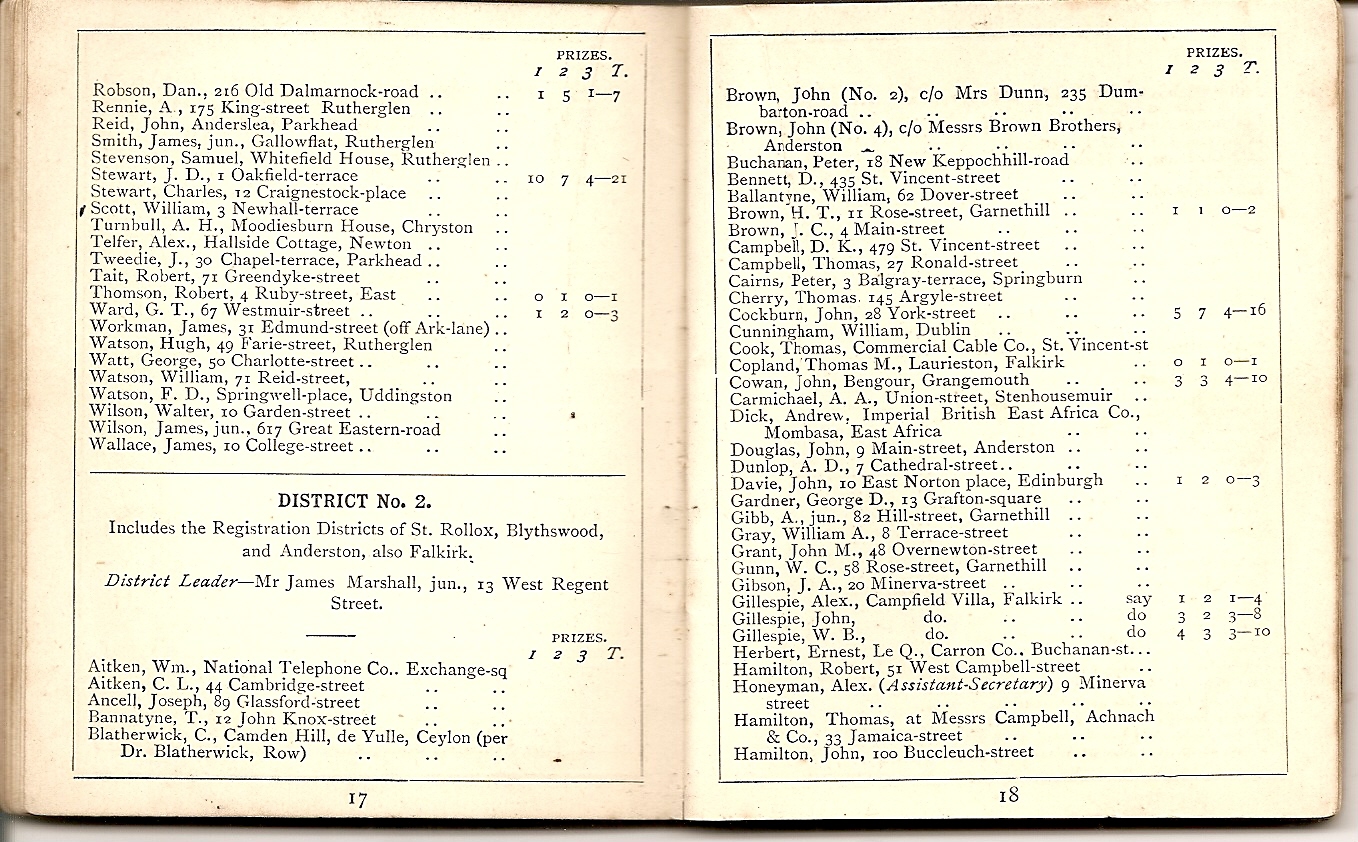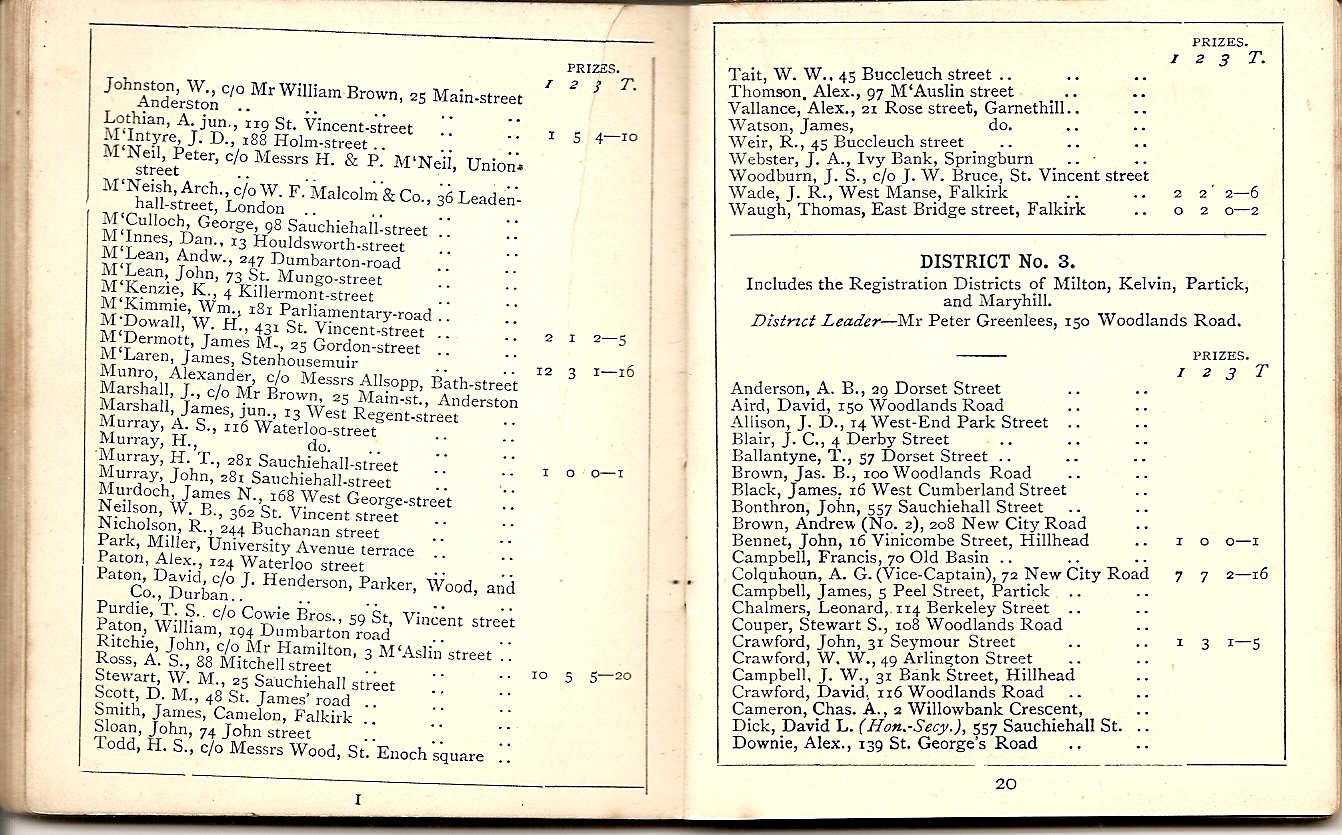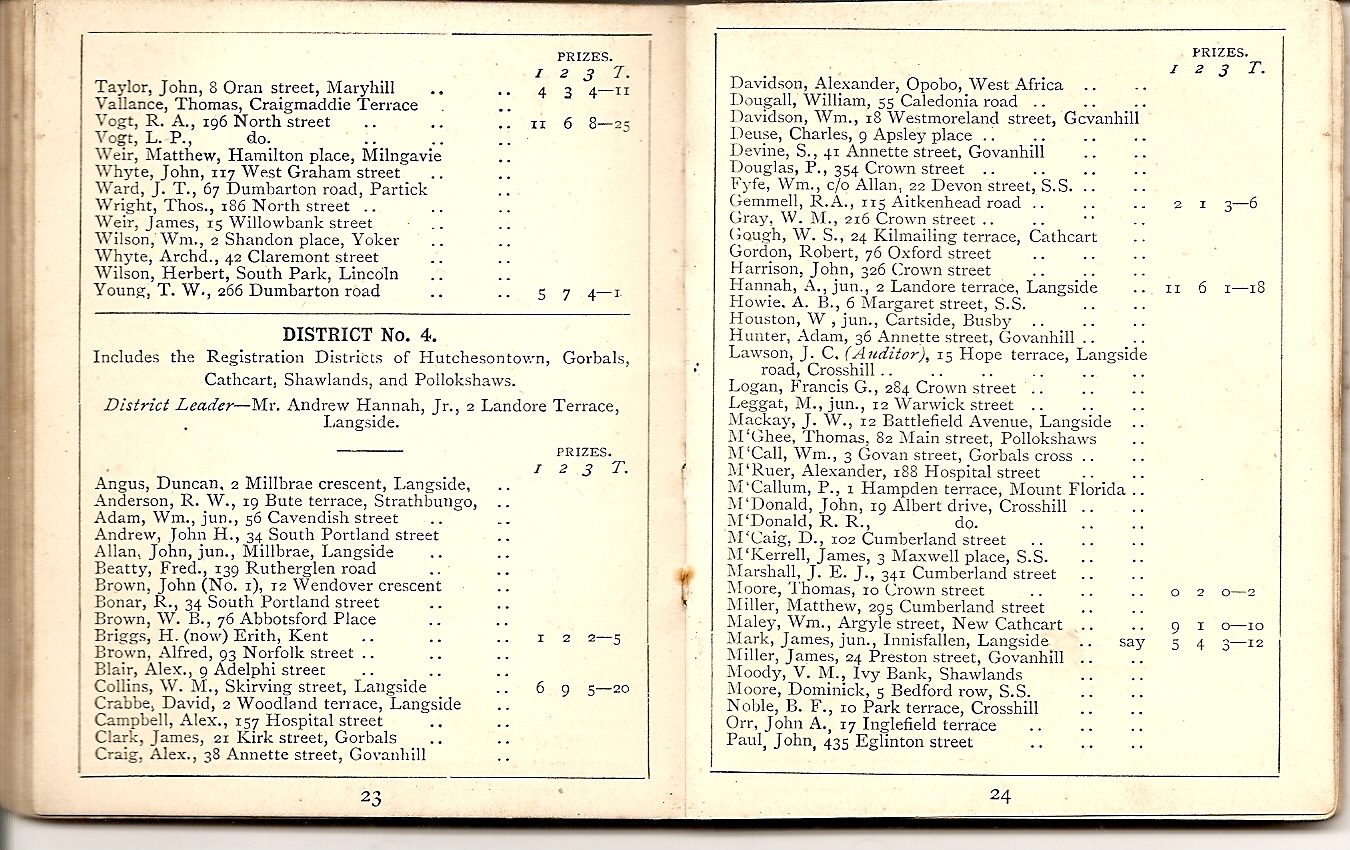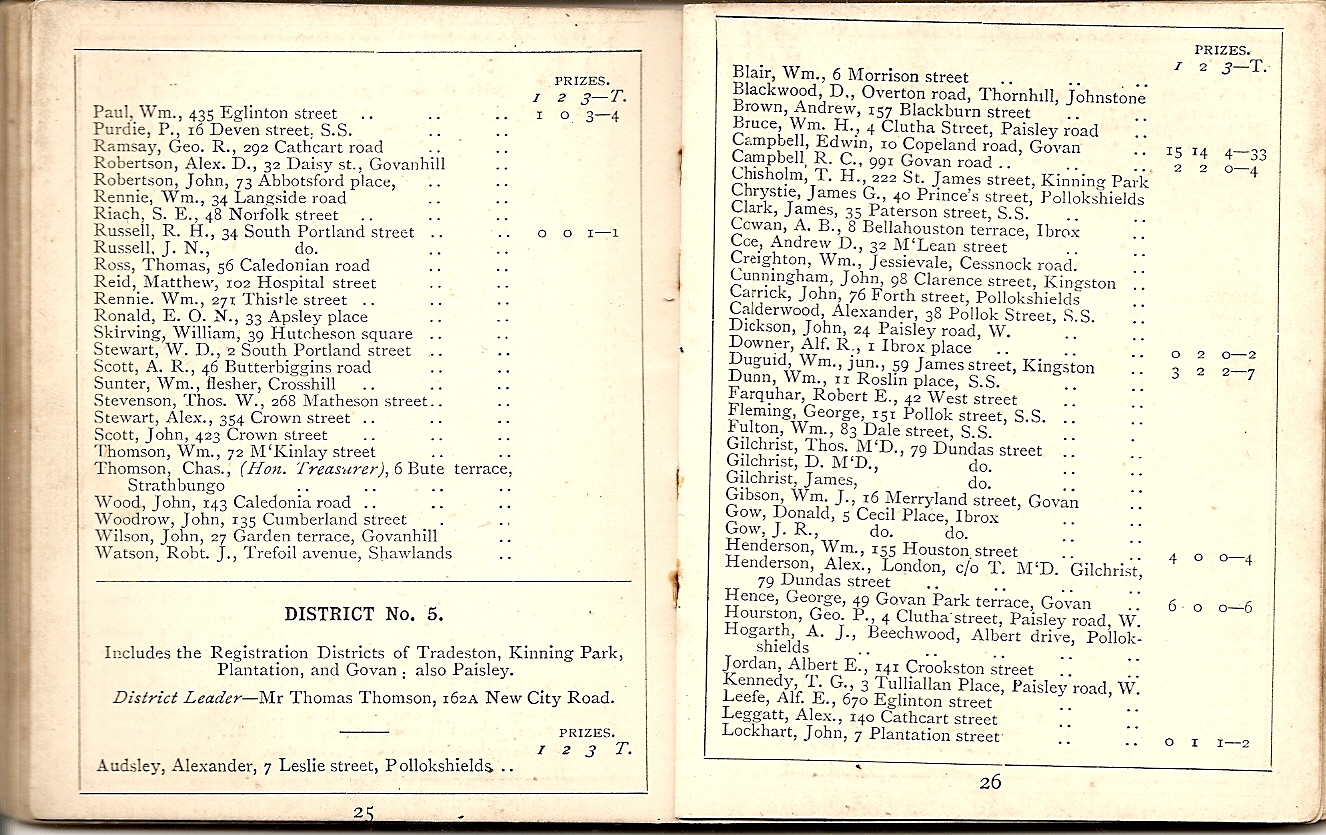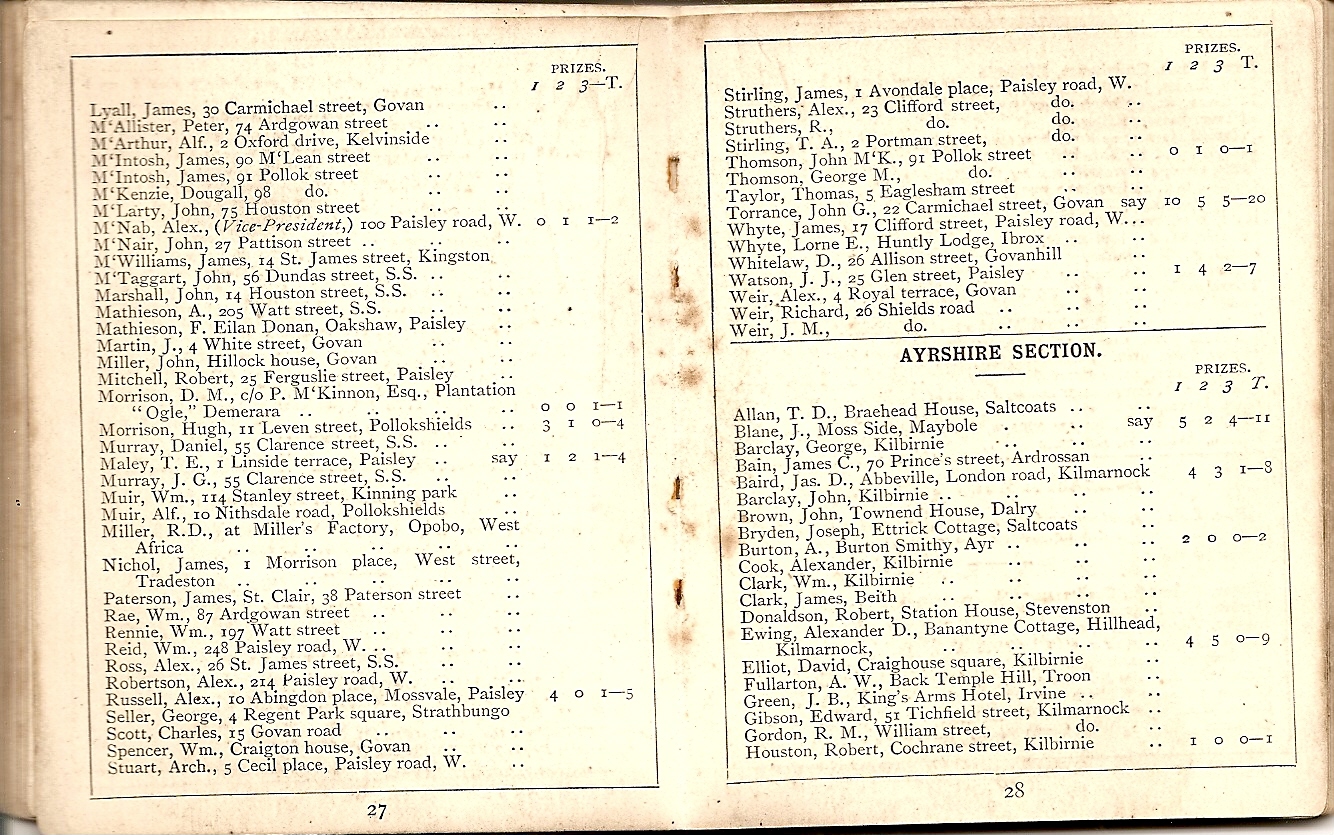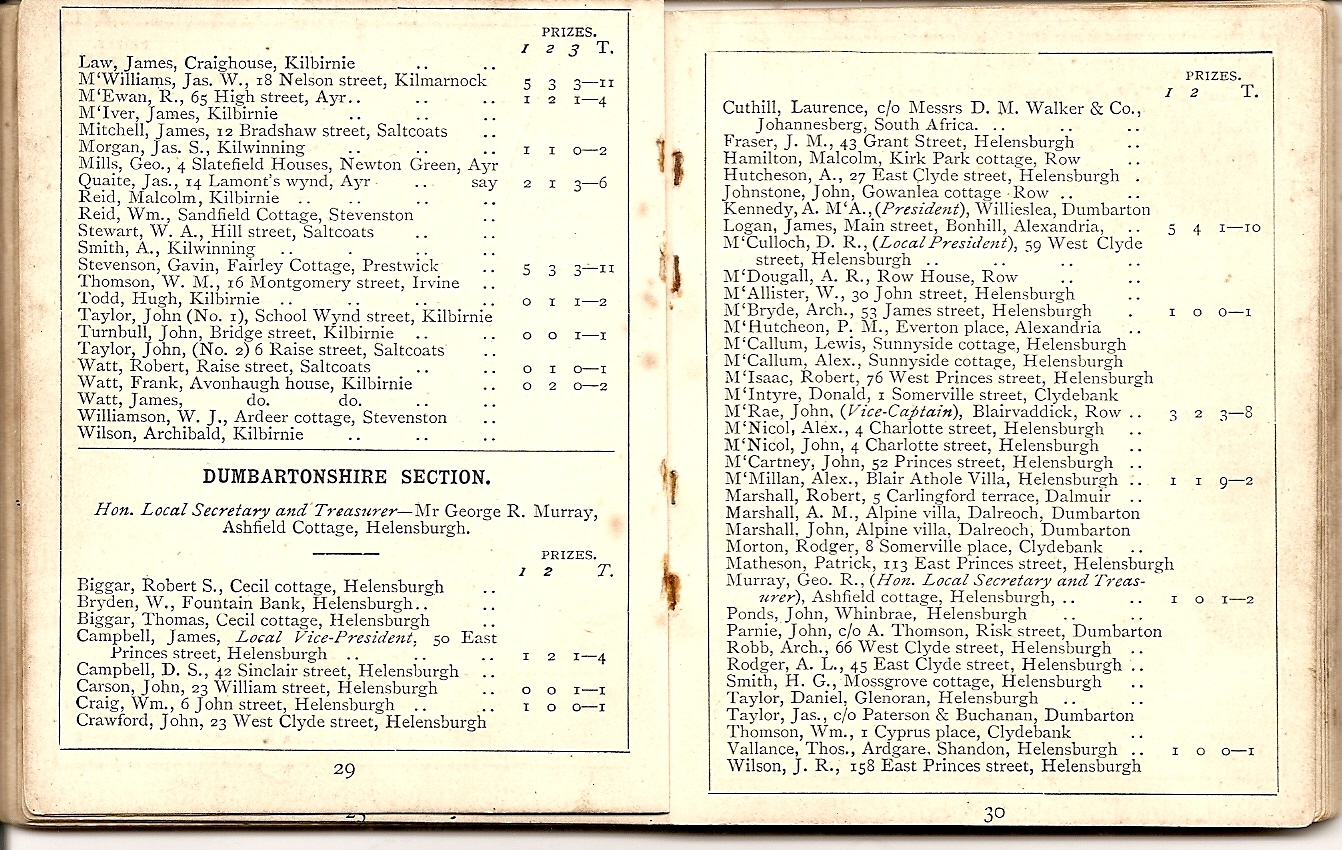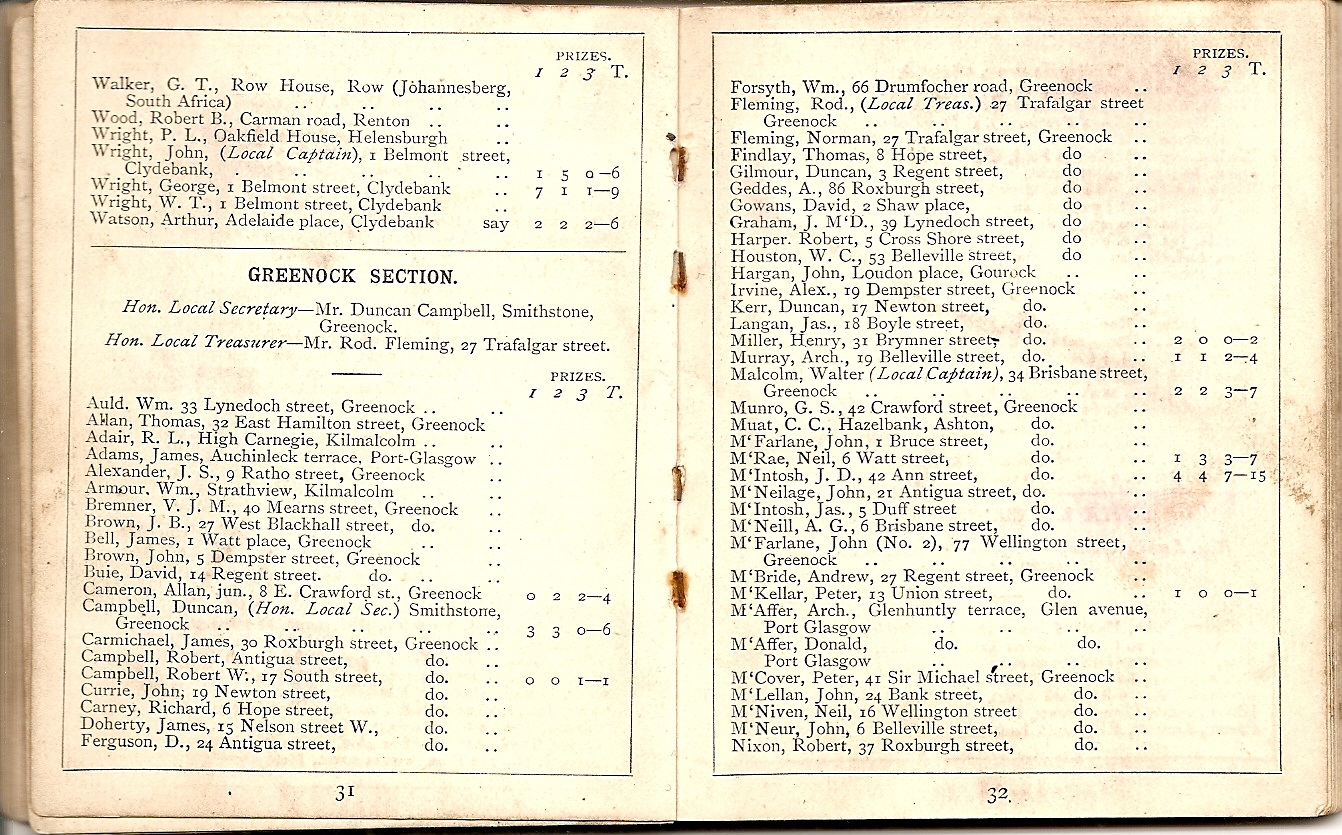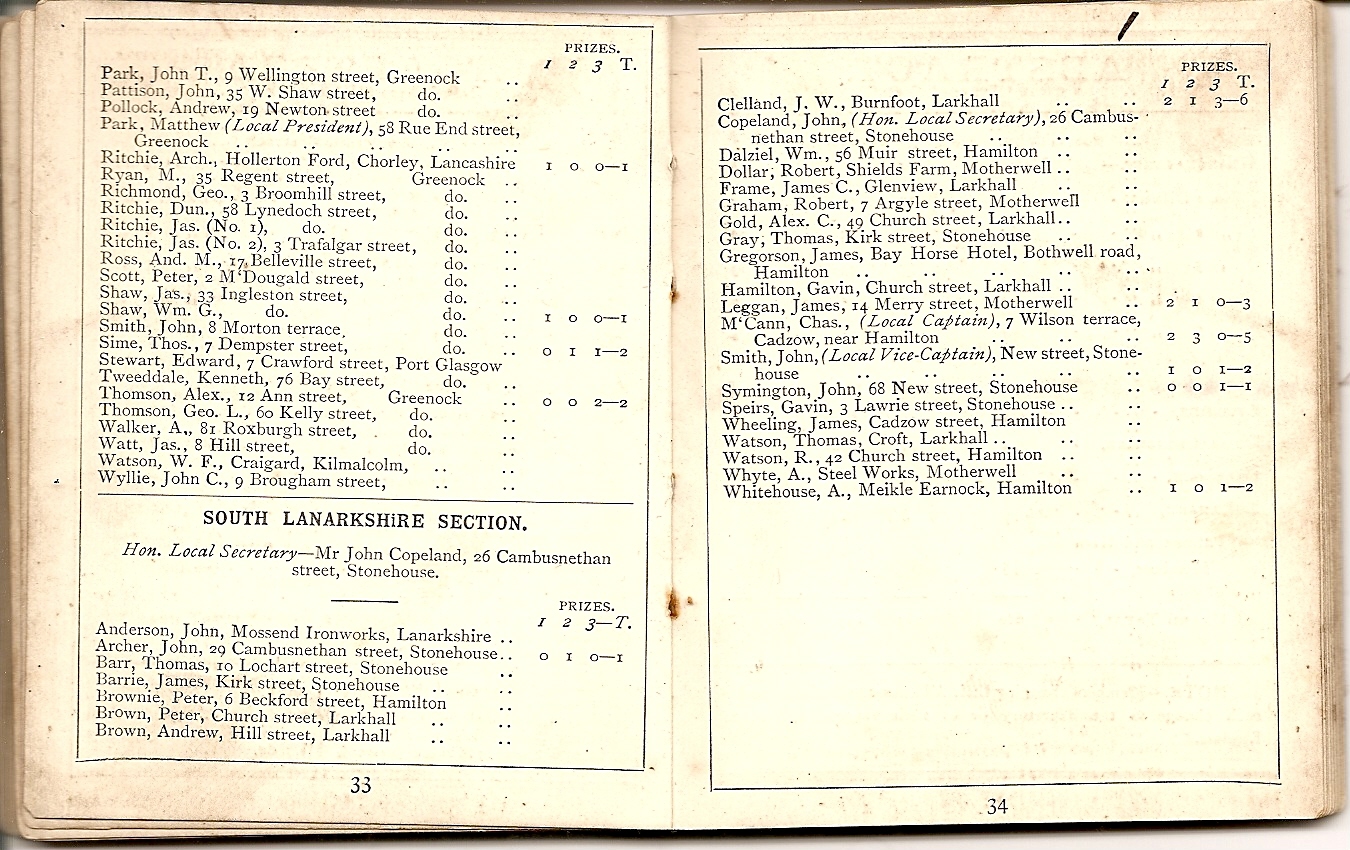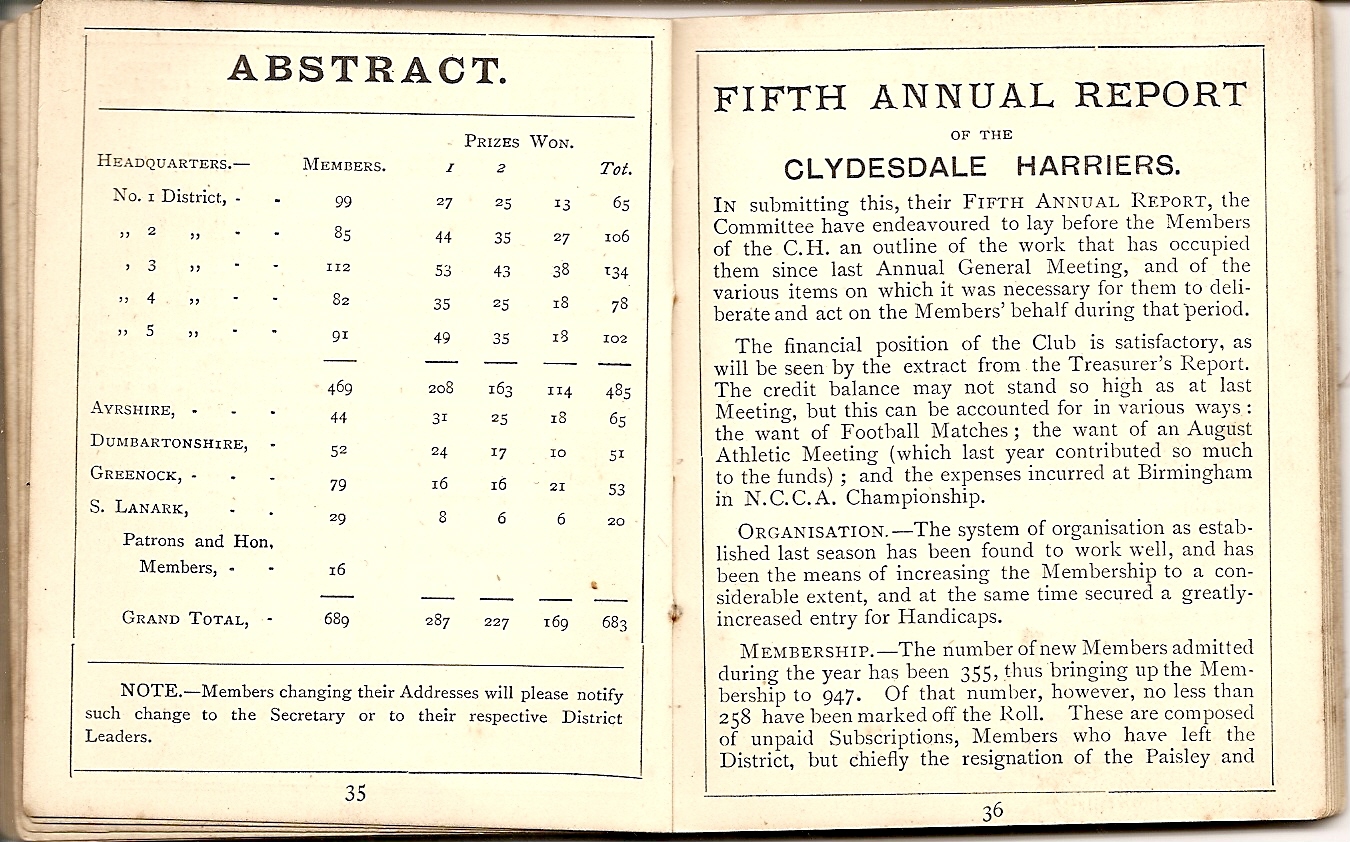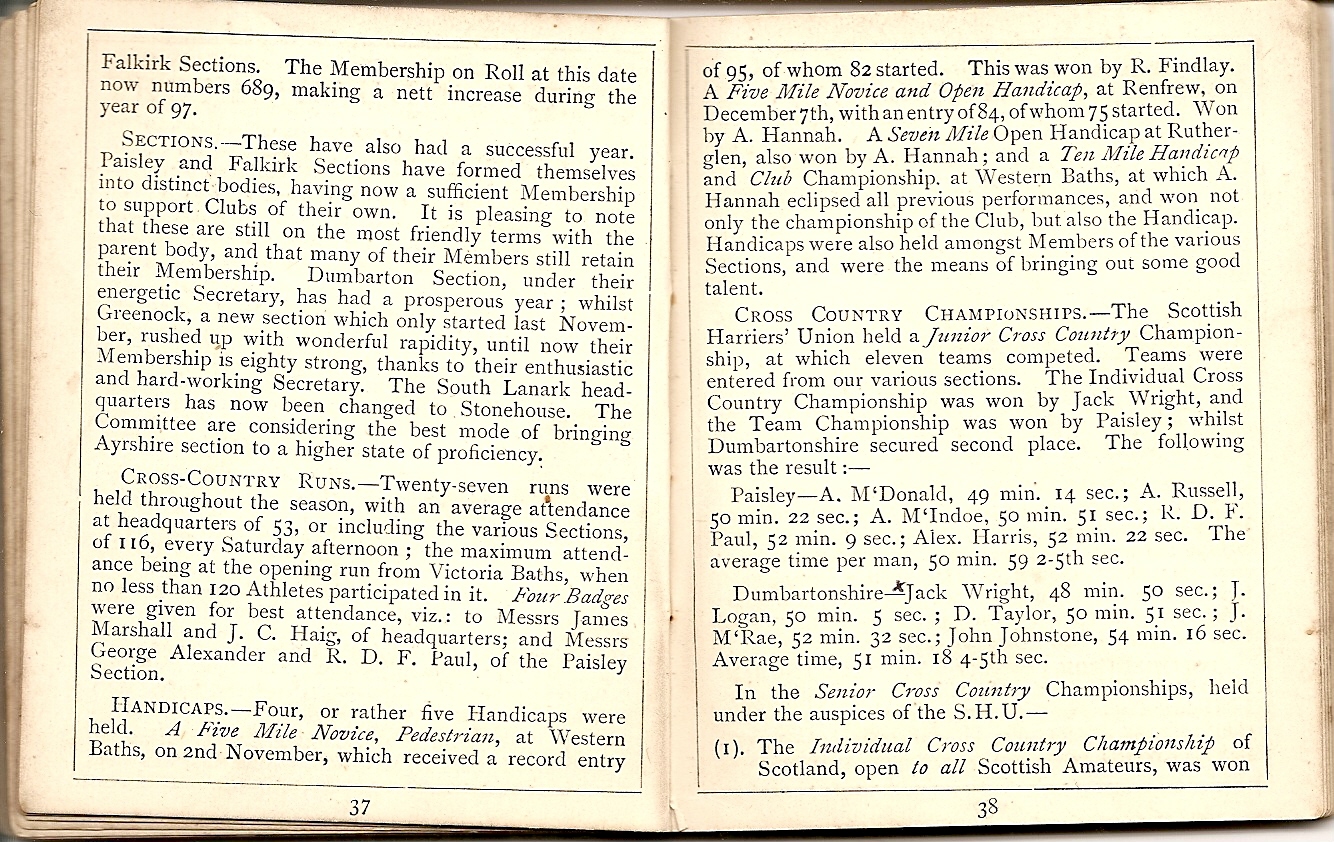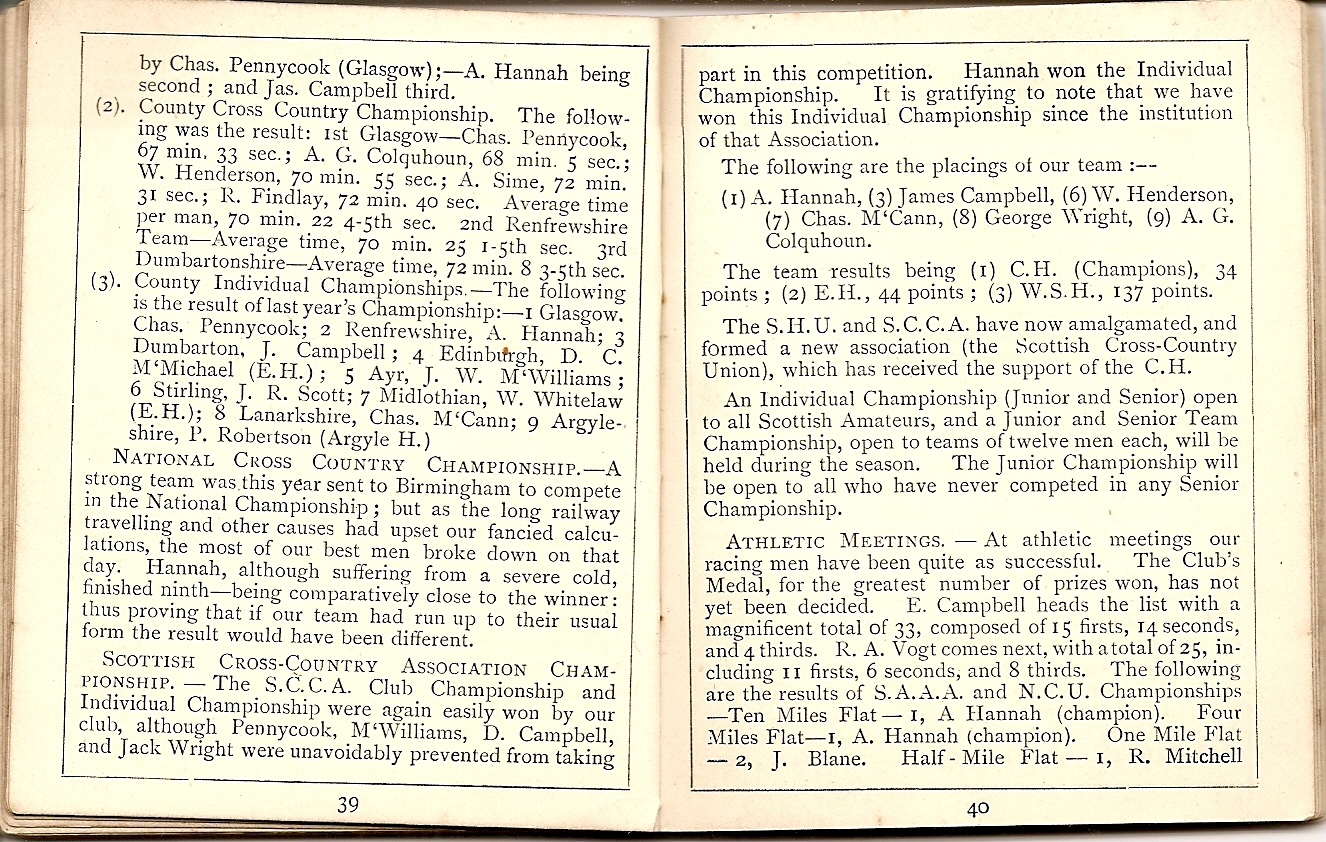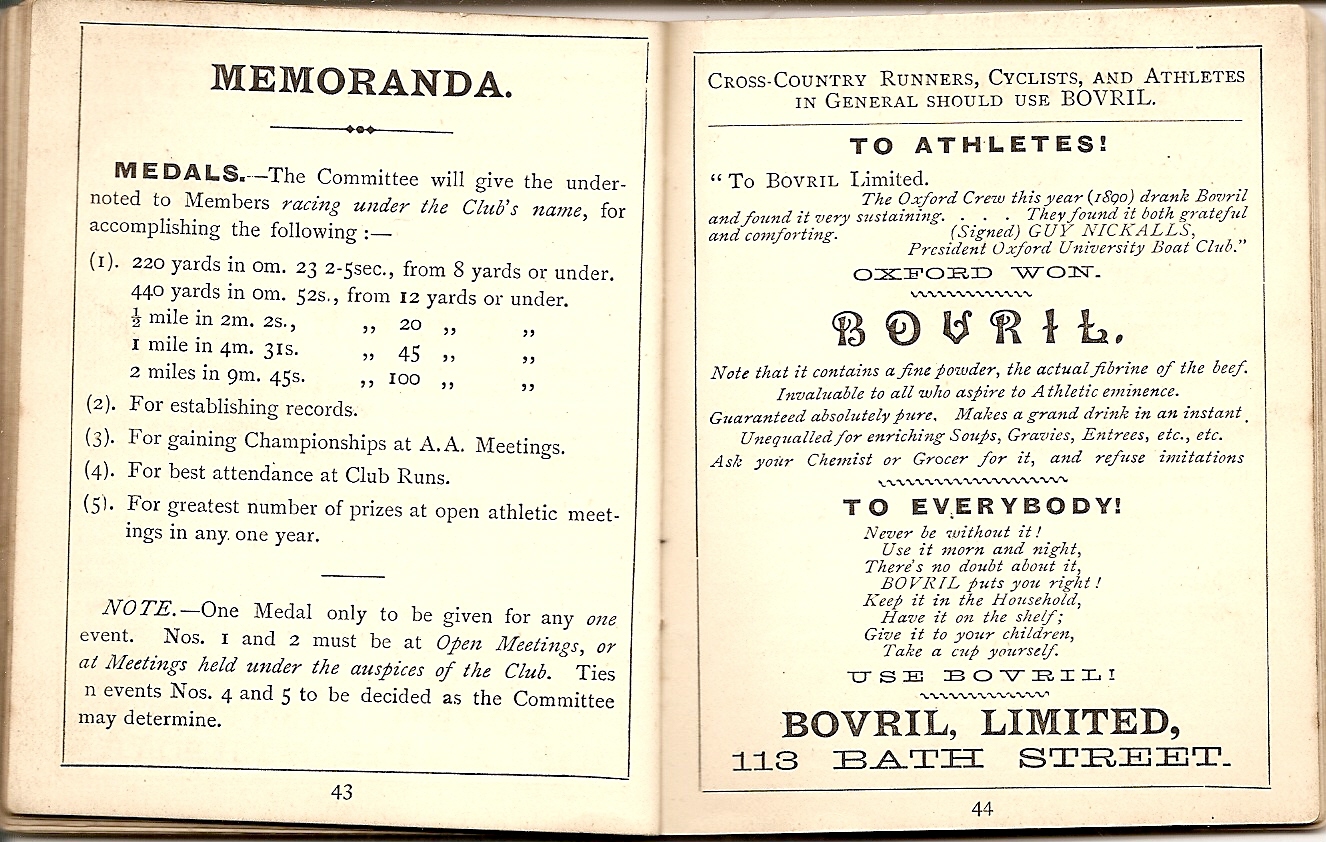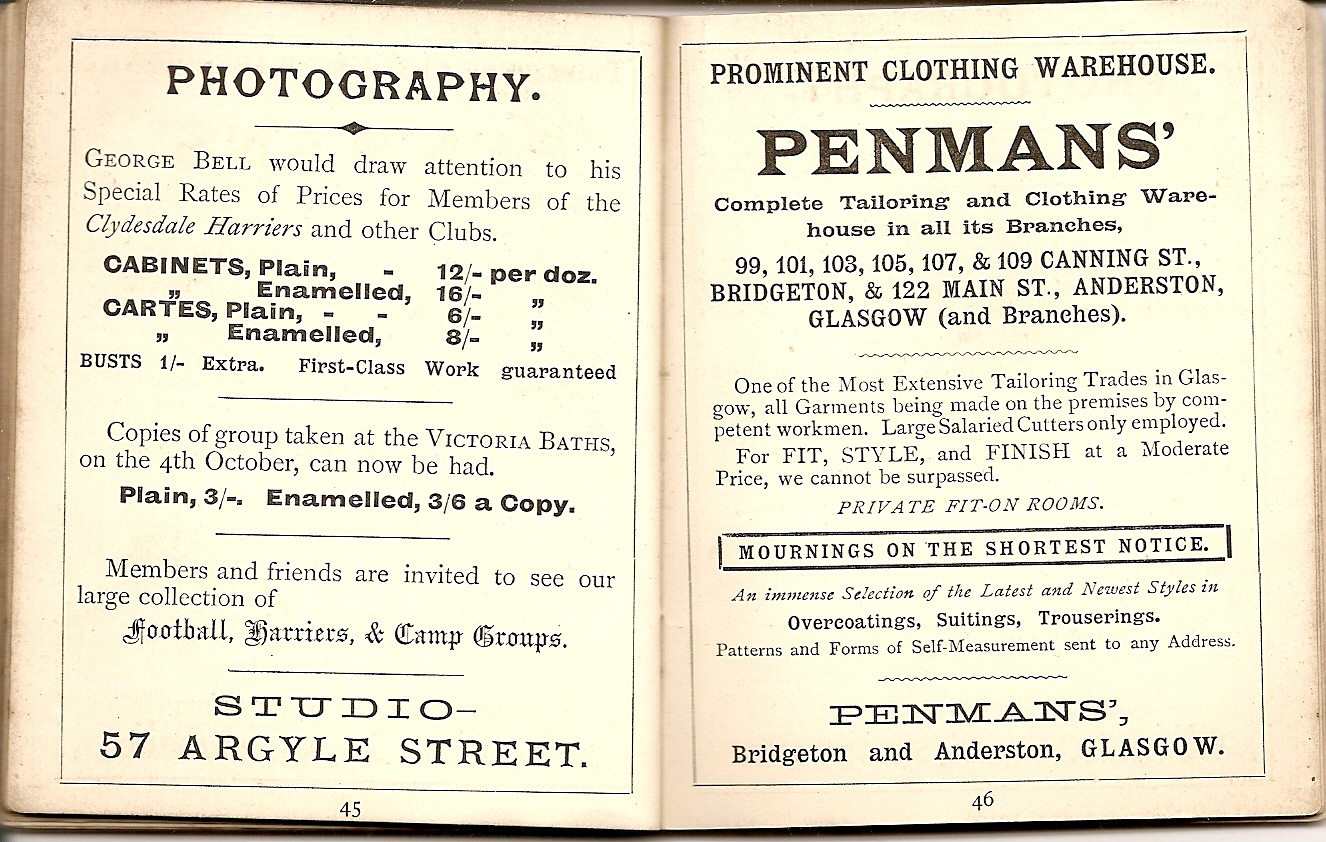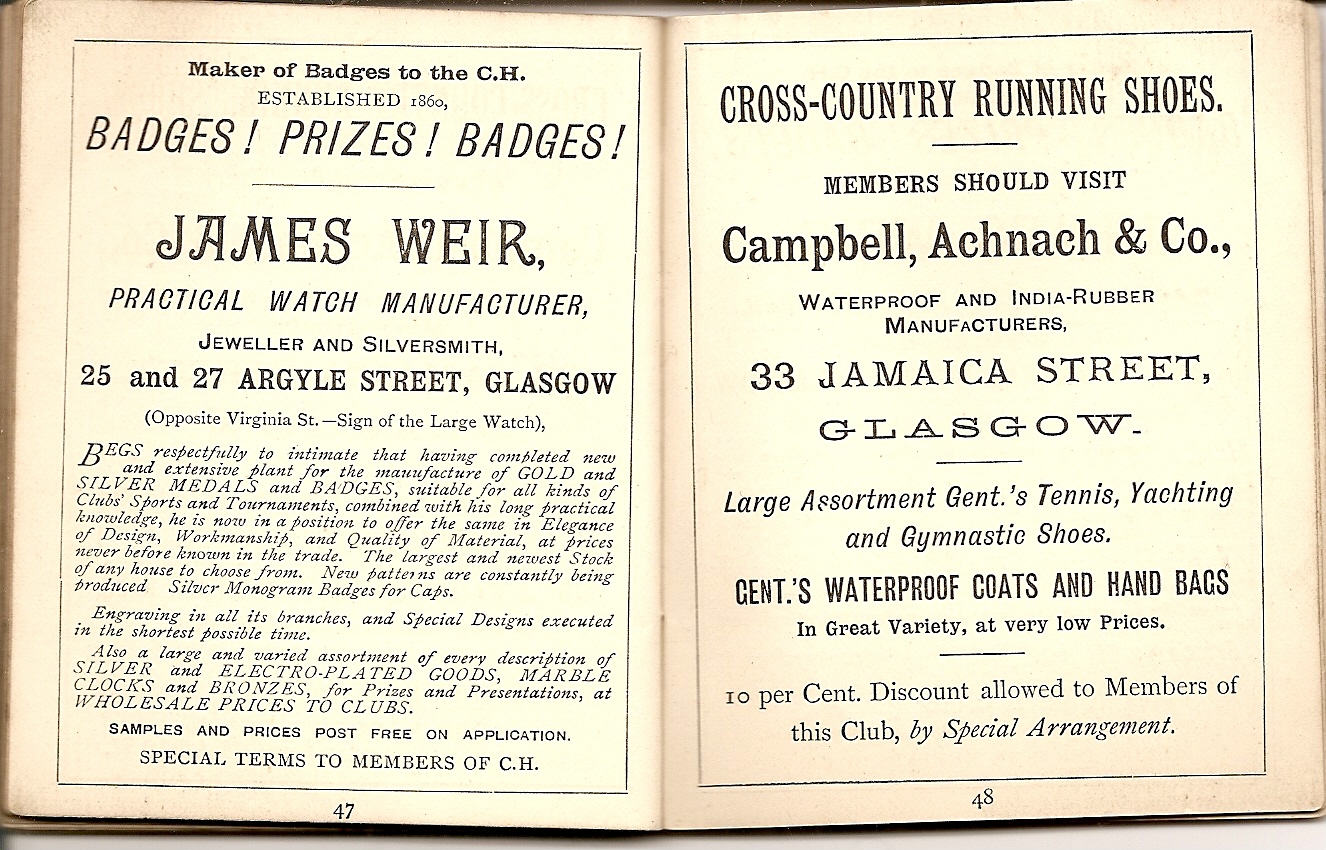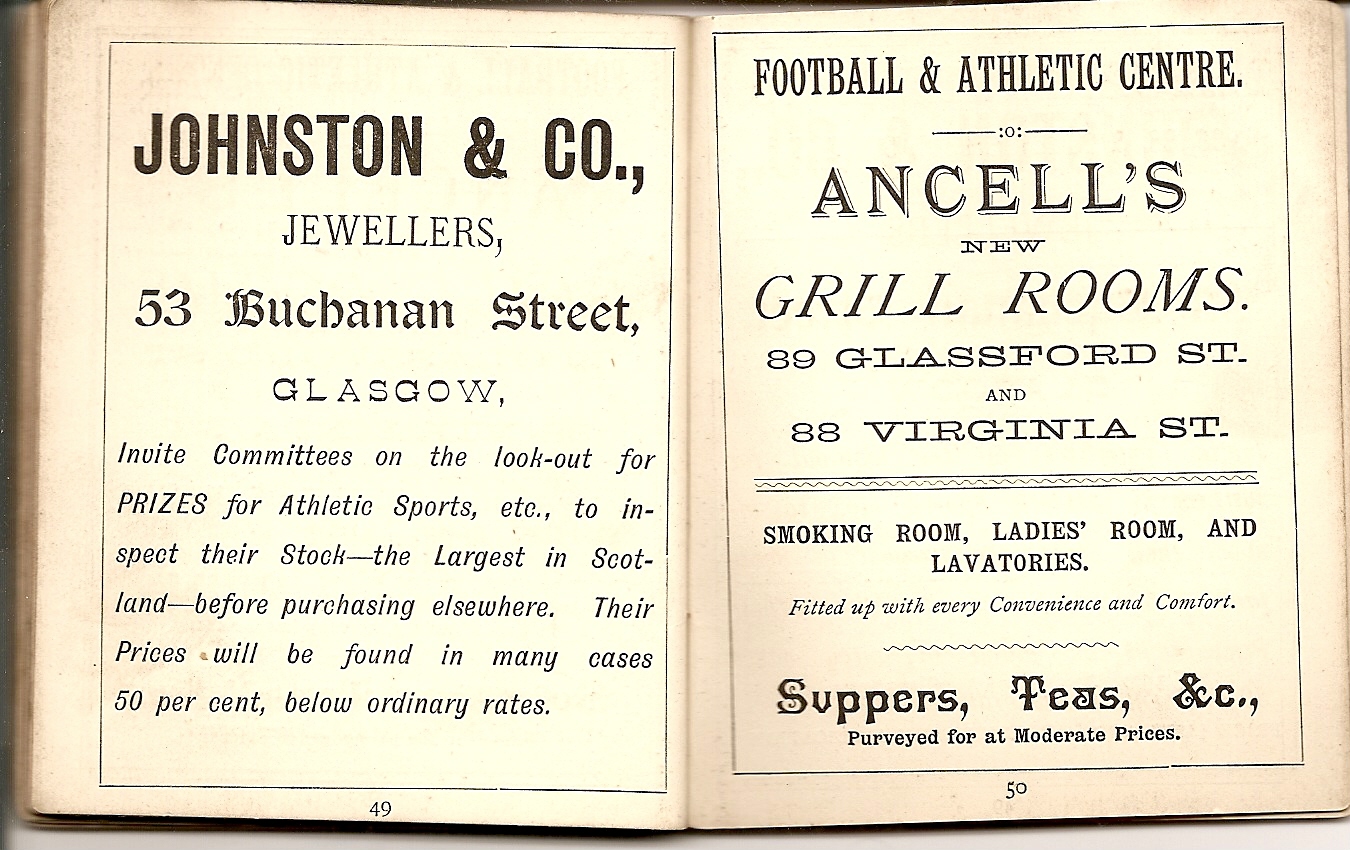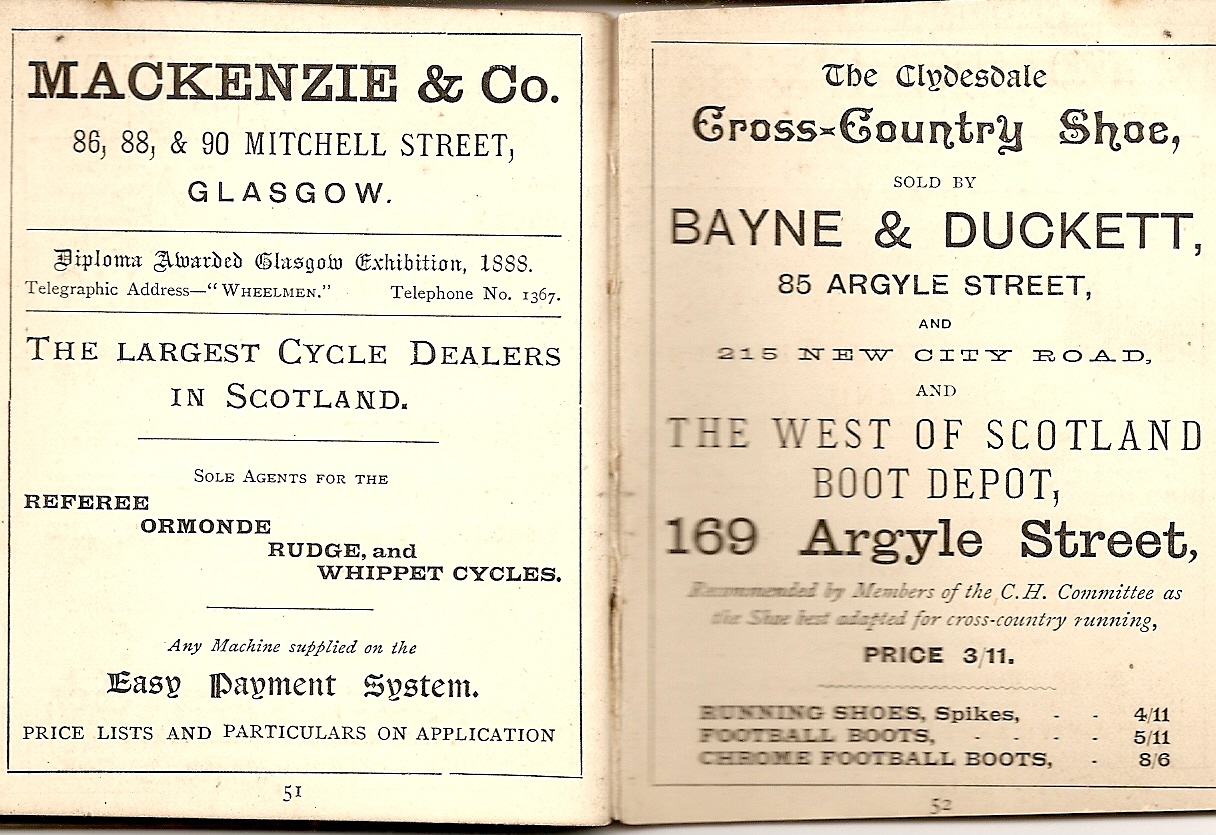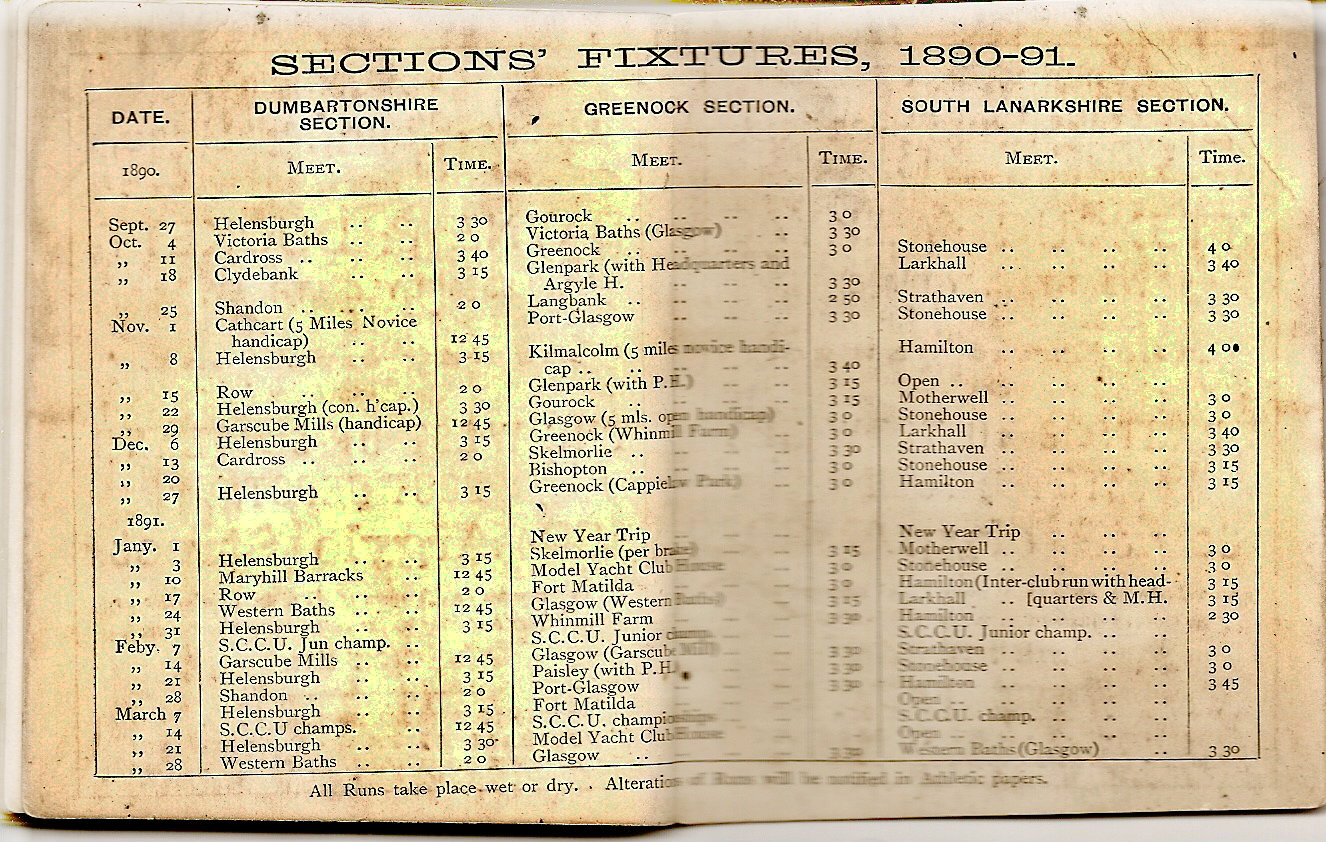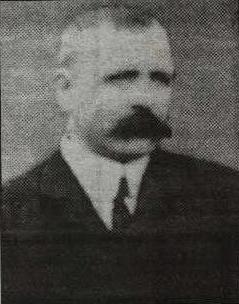The gentleman (and I use the word advisedly) above is the first honorary president of Clydesdale Harriers until his death in 1895. There is a complete profile of “Blatherwick of Row” available if you follow this link where not only do you have an outline of his career and occupation but various other interesting facts about the setting up of an amateur athletic club at that time. This section looks at the running of the club in its early years when there were very few (at times no) races. So rather looking at results or runs done we can start where the club started – with its Constitution as set out in the club’s handbook, and then a look at the handbook to see how these rules were implemented
First: THE CLUB CONSTITUTION
There were no other clubs in existence and no club constitution to use as a guide but there were gentlemen’s clubs in all the major cities and towns who did have such documents. It is not accidental that the Clydesdale Harriers constitution resembled them I reproduce it in full.
RULES
I. That the club be called “The Clydesdale Harriers”
II. That the object of the Club be the promotion of Amateur Athletics generally, and Cross-Country Running in particular.
III. That the general management of the club be vested in a Committee not exceeding Twenty-Four Members of whom Fifteen shall be elected at the Annual General Meeting of the Club, including, at least, a President, Vice-President, Secretary, Treasurer, Captain and Vice-Captain, the remaining members to be elected by the Committee and by the Sections (one from each section). Seven Members to form a quorum.
IV. That each candidate for election upon filling up a form (on which the Rules of the Club are printed) declaring that he is an amateur and that he will abide by the Laws of the Club and of the S.A.A.A., shall be proposed by one member and seconded by another, after which his name will be submitted to the Committee, and if agreed upon, passed. Any Member of Committee shall have the power of demanding a Ballot in the case of any Candidate. One black ball in four to exclude.
V. That the Annual Subscription for Ordinary Members be two shillings and sixpence, payable on 1st October each year; Honorary Members five shillings, and that the Subscription for Life Members be One Guinea. New Members Subscriptions must be paid within One Month from the date of notice from the Secretary that their application has been passed, otherwise their election may be declared null and void.
VI. That the Treasurer shall place before the Committee the names of all Members one month in Arrears for Subscriptions or other monies, the Committee then having the power to erase the names of such Members from the books, as well as to enforce the payment of such Subscription, and no one whose Subscription has been allowed to fall into arrears shall be entitled to the rights and privileges of the Club.
VII. That any member intending to withdraw from the Club shall give written notice to the Secretary before the Annual General Meeting, or be liable for another year’s Subscription.
VIII. That any Member violating the Rules of the Club, or of the S.A.A.A., or doing anything prejudicial to the interests of either, may be expelled from the Club by the votes of two-thirds of the full Committee.
IX. That the uniform of the Club be Black Knickers and White Jersey, and that the Club Badge (a Horn and Whip, with the motto “Excelsior”) be worn on th left breast at Athletic Sports, and the Gate Badge on the back at cross-country runs. Members are specially requested to enter under the name of the Club at Athletic Meetings).
X. That the Committee shall appoint an Advising Board of experienced members to confer with and advise the Secretary as to matters requiring to be dealt with by said Committee, and generally to watch over the interests of the Club. The Committee shall also allot the management of the Head-Quarters Districts to certain of its members who will look after the Districts, and assist the Secretary and Treasurer so far as these are concerned, the Section Committees appointing their own District Managers and otherwise looking after the immediate business of their Sections. The Committeeshall also appoint a Business Committee and any other Sub-Committees that which they may consider advisable, and have full power to fill up vacancies in General Committee and act for the Club (except to alter Rules), the majority in all cases to decide, the Chairman or President of the Club, however, having the Power to appeal to a full Special General Committee Meeting. Proxies to be allowed at such meetings only. That the Meetings of Committee be held on the first Thursday of each Month, or as near that date as possible, at least two days notice to be given by the Secretary when, together with other current business, the Minutes of the Advising Board, and of the Business and other Sub-Committees, as well as the Treasurer’s Financial Statement to the end of the previous Month shall be read and considered.
XI. That the Annual General Meeting be held early in September and called by notice in at least one weekly athletic paper and in one of the Glasgow evening newspapers not less than ten days before such meeting. The Reports of the Secretary and Treasurer will be submitted , and the Office-Bearers and Committee (with Auditor to act in conjunction with one appointed by the Committee) appointed for the ensuing year. Twenty five members shall form a quorum; a majority to decide. The Chairman shall have the power to appeal to a Special General Meeting on any special business, at which there must be fifty Members, either personally or by proxy.
XII. That a Special General Meeting may be called by the Committee, or by any ten Members, or (in the above special case) by the Chairman by giving notice to the Secretary, who shall call the meeting in the same manner as the A.G.M.
XIII. That these Rules be annexed to the Forms of Election and inserted in the Club’s “Annual”, and that no alteration in, or addition to, the Rules be made except at the Annual General Meeting, or at a Special Meeting called for that purpose. Ten days notice of such alteration to be given to the Secretary.
–
CROSS-COUNTRY REGULATIONS
I. That cross-country runs be held on Saturdays, from the 1st of October to the end of February, on such dates as the Committee shall fix.
II. That the Club, when out for a run, shall be under the management of the Captain or Vice-Captain, or Senior Member of Committee present, who shall appoint a Pace-Maker and Whip for the control of each pack.
III. That no one, when out for a run, shall be allowed to go ahead of the Pace-Maker, unless the run be a racing run, or the signal be given by the Pace-Maker for a race home.
IV. That every member of the club is expected to wear the Club Uniform at the Club Runs, and to support the management for the time being.
Second: THE CLUB ANNUAL AND MEMBERS TICKET
The various points in the Constitution can be looked at by going through an actual Annual. These were impressive documents and very detailed, covering every aspect of the Club’s activities for the preceding year and with a list of fixtures for the coming season. Many of them are available for further scrutiny at www.anentscottishrunning.com/clydesdale-harriers-1890-1900 . These booklets, asyou can see from the example above, doubled as Membership cards or ‘Member’s Tickets’ and all members received the booklet on paying their Subscription at the start of the year. We should start at the beginning. When we open the cover of the Annual and Member’s Ticket for 1890/91 ran to 54 pages plus hard cardboard cover.
The inside front cover has the fixtures for the Headquarters sections. The club headquarters sections totalled five in number covering the entire city. There were runs every Saturday and the second column indicates that these were scattered from Greenock and Gourock in the south and west to Kirkintilloch in the north and east of Glasgow as well as near at home. The thirdcolumn indicated meeting points and method of transport to these venues: four different stations as well as cars. The fourth column has times for assembly, note that the train times were very precise – 2:26, 3:03, 2:48, etc. No member had any excuse for not knowing where the meeting was or when to be at the assembl;y point. I always scorned the word ‘meet’ as a description og an athletic event, reckoning it was an Americanism, but the comment at the foot of the page uses the word “Meet” in just that sense!
Pages three and four were full page advertisements for David Dick’s, Chemist and Clydesdale Harrier, products. On the Kola preparation MF Thomson is quoted as saying “The drug is not only invigorating but also possessed of medicinal properties which are beneficial.” Actually referring to it as a drug – how times change.
Note the discount for club members at the foot of page four, this ties in with the reduced rail fares mentioned on the preceding pages. The club was probably paid for the space and the athletes mentioned as endorsing the products may well have received payment of some sort.
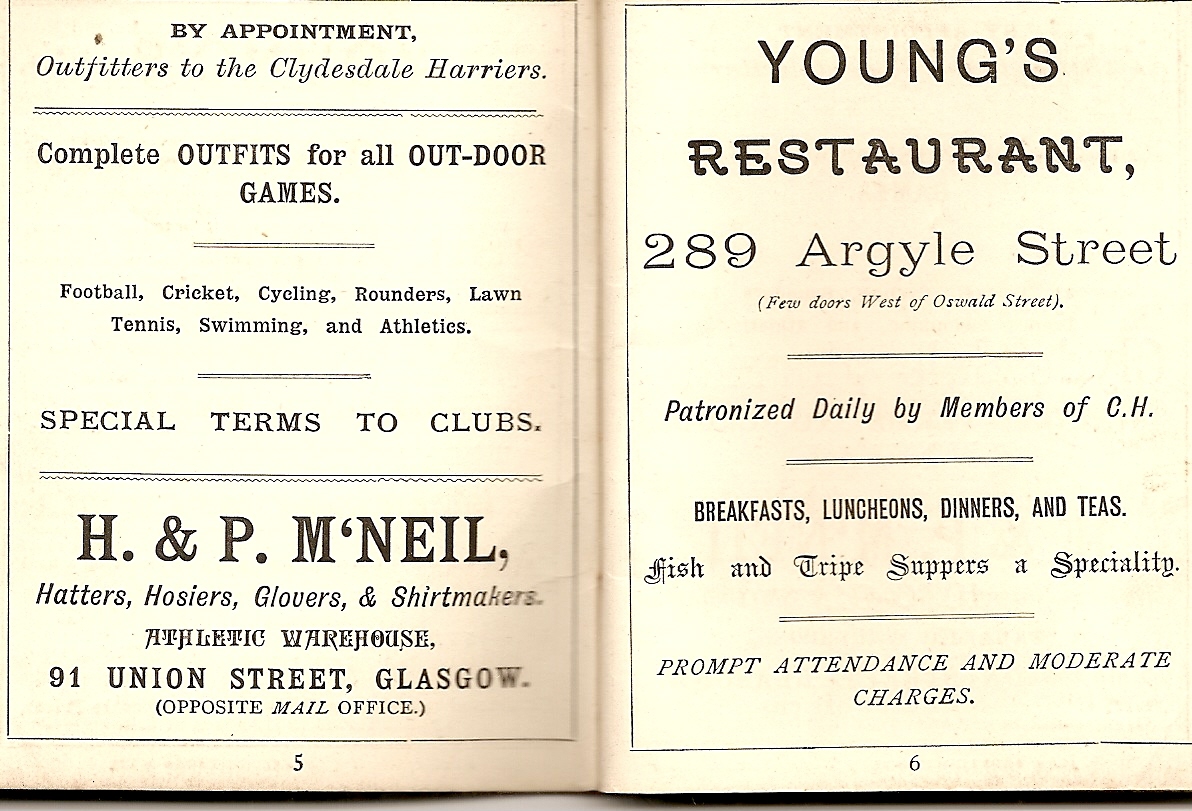 Two moe pages of advertisements. H and P McNeil were founder members of both Clydesdale Harriers and the Rangers FC . Outfitters to Clydesdale Harriers – whenI joined theclub in the 1950’s club clothing was sold from Harris’s of Exchange Square in Glasgow. They kept stocks of club uniforms in all sizes and we simply wandered in and bought them. It saved anyone keeping a stock in their home and the shop kept a suitable number of vests as sold by them. The other ones found it paid to advertise ‘Tripe Suppers’. Might not go down too well nowadays. Is there any reason why a club member could not be responsible for adverts for a club annual in the twenty first century
Two moe pages of advertisements. H and P McNeil were founder members of both Clydesdale Harriers and the Rangers FC . Outfitters to Clydesdale Harriers – whenI joined theclub in the 1950’s club clothing was sold from Harris’s of Exchange Square in Glasgow. They kept stocks of club uniforms in all sizes and we simply wandered in and bought them. It saved anyone keeping a stock in their home and the shop kept a suitable number of vests as sold by them. The other ones found it paid to advertise ‘Tripe Suppers’. Might not go down too well nowadays. Is there any reason why a club member could not be responsible for adverts for a club annual in the twenty first century
By pages seven and eight we were into the handbook proper. Google the names of the patrons several MP’s – George Otto Trevelyan was twice Secretary of State for Scotland, Cameron Corbett was the first Lord Rowallan and so on. Not run-of-the-mill politicians but even had they been, they would have been worth encouraging. All athletics clubs need help from politicians at some point or other and even local councillors should be solicited. In my time in the Harriers we had many local politicians (Malcolm Turner, Jimmy Malcolm, John Johnstone) and members of parliament (most recently was Tony Worthington)
Pages nine and ten were the start of the working committee. Secretary DL Dick was the chemist who was advertising earlier in the annual. The President was Sir Alexander McAusland Kennedy who was a really important player in the ship building industry north and south of the border – google him and you will be surprised at how big a profile the man had. He chaired all the club’s importantanniversaries up to 1935 – the 50th. Captain Charles Pennycook won the SAAA Mile title and was President of the SAAA later in his career. Then there are the sb-committees – the advertising and business committee and the football committee (both Rangers and Celtic clubs were represented here by paid-up members of Clydesdale).
The whole sections and headquarters edifice was well knitted together – separate committees for each section had a rep from the general committee, and the general committee had reps from the sections present. Every section always knew what was going on. There were no secrets.
Eleven and twelve were the start of the constitution.
Page fourteen was the start of a big section that listed the names and addresse.s of every single club member for the use of the officials and of each other. Glasgow had five sections, each section had its area of influence delineated and the District Leader was noted with his address.
As well as the address, the annual listed the prizes won by each athlete and sorted them into first, second and third. Of course most won nothing at all but it is an interesting feature. Creating and maintaining such a list would have been a serious job of work: I doubt whether any club member of any club would take such a task on in the twenty first century. Those who had gone abroad for business reasons had their new addres listed but were kept in the sections that they had been members of before emigration. James Erskine of Gray Street was a founder member and father of Ralph and Thomas Erskine who both died in the 1914-18 War.
Several well-known names here too: Peter McNeil whose firm was advertising at the startof the Annual and Alex Vallance, SAAA champion hurdler, Rangers FC player and brother of the better-known Tom. DL Dick appears again – on p20
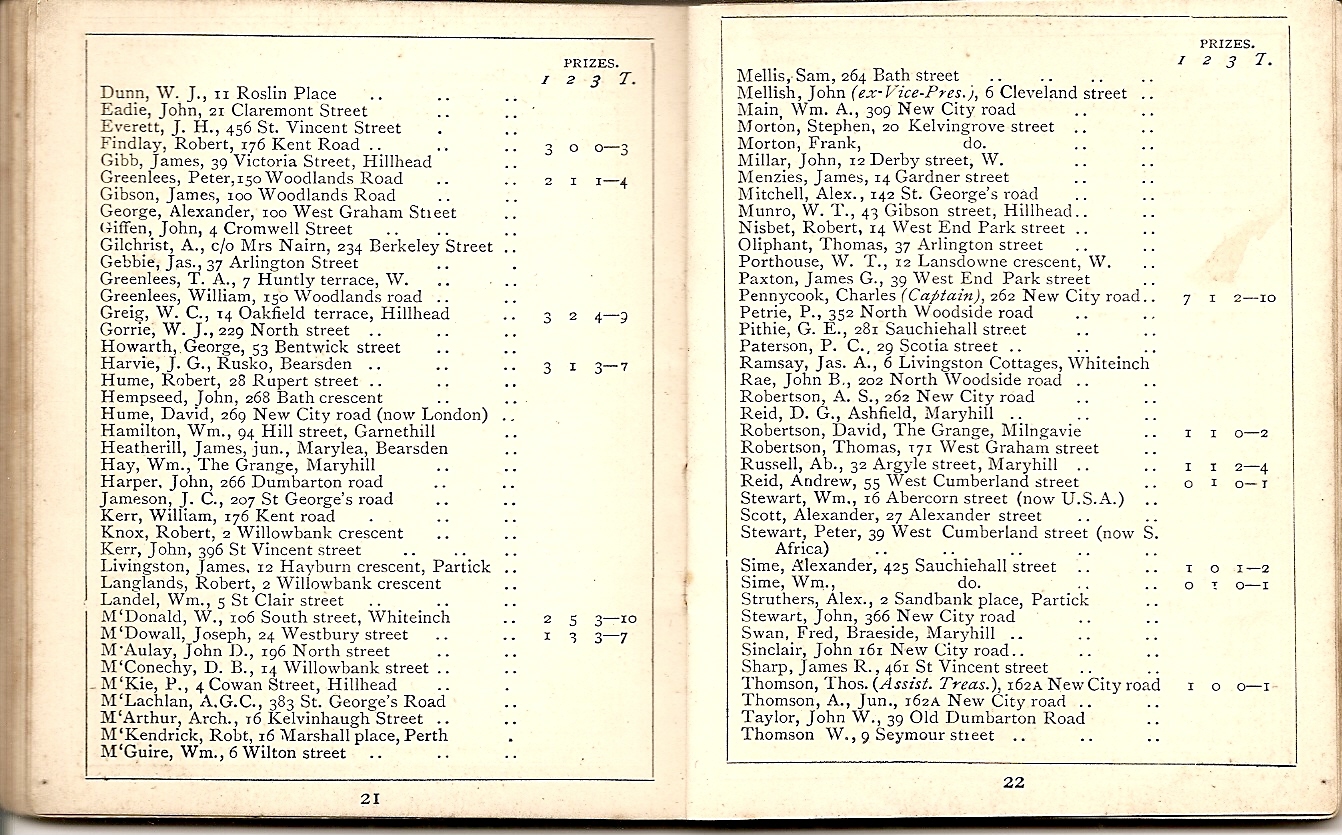 Who’s on this one? Robert Langlands for a start – the first Scotsman to run inide 2 minutes for the half mile. John Mellish was the man who “allowed his name to go forward for President of Rangers” and a man who was very active sorting out the split between CH and the SAAA.
Who’s on this one? Robert Langlands for a start – the first Scotsman to run inide 2 minutes for the half mile. John Mellish was the man who “allowed his name to go forward for President of Rangers” and a man who was very active sorting out the split between CH and the SAAA.
Tom Vallance, RA Vogt the record breaking cyclist, Andrew Hannah, and (balancing Vallance of Rangers, Maley of Celtic (who won 9 firsts and one second that year.
One of the biggest names ever in athletics here – on page 26 is Alf Downer who ran for several clubs in his career but won the triple treble – ie the 100, 220 and 440 at three consecutive SAAA championships. Further down the same page is JR Gow – another SAAA champion hurdler and record holder as well as a Rangers FC player.
The Ayrshire Section was one of the first that the club set up and there was an annual athletics contest with Ayr United FC which some said was more important than the SAAA Championships. Alex Finlay, the first NCCU champion, was from Ayr and John Blane, mile record holder and champion came from Kilmarnock. Note Tom Maley’s address in Paisley.
Lots of well-known names here – A McA Kennedy; James Logan, an outstanding miler; Tom Vallance’s Helensburgh address too.
The Wright brothers – Jack who was Junior cross-country champion of Scotland and a noted half-miler with brother George, a very good sprinter – were the start of a lineage that went down through three or four generations in the club.
And the names and Sections continue – listing the names in this fashion and then handing the lists to each member must have given Clydesdale Harriers individual runners the feeling of being part of a big pioneering movement. Confidence grow from numbers and being part of something big.
The information on the previous pages is summarised and laid out in a most impressive table on page 35 and the Annual Report(quite often also written into the Minute Book) accurately summarised the past year for the benefit of members and those others whom the committee saw fit to pass it on to (eg some sporting papers). For us it provides a running commentary on the development of a club.
It’s a pretty comprehensive report by any standards – club section championships, club championship, Scottish and British national championships, track and field and internal club politics are all covered. Note on p41 the comments about the club rooms in Dundas Street, Glasgow. Verily a gentleman’s club and a step up from a club hut!
The criteria for club medals are clearly laid out on p43 and the gold ones for establishing records or winning SAAA championmships were sought after – the club minute books have the requests for these by such ‘stars’ as long jumper Hugh Barr noted as discussed and awarded. The winners all submitted their claims for them. Interesting too that Bovril was sold in Chemists as well as Grocers.
More paying advertisements-and the offer of discounts for members of the club indicates that it was woirth while for the firm and that encouraged more to join Clydesdale Harriers,.
Note the level of literacy required to read and understand the advertisement on p47! The club always had a ‘club jeweller’ who provided all trophies, medals and badghes at good rates for the club. Again – special terms to members of Clydesdale Harriers.
Bicycles on hire purchase! Spikes for 3/11 – less than 20 pence in new money!
The inside back cover of the ‘Members Ticket. The fixtures for the sections. A meet a week and venues with times. No member ever in doubt about where that week’s run was to take place.
Andrew Hannah
